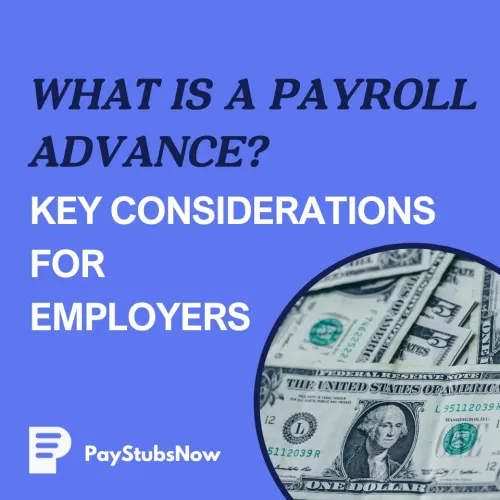


Ever found yourself puzzled by the concept of payroll advances and how they might suit your business? Offering this perk involves many considerations. From understanding the mechanisms of payroll advances and their alternatives to dissecting the legal and financial landscape, there's a lot that employers need to keep in mind.
In this blog, we’ll demystify the concept of payroll advances, explore the different types available, and guide you through the necessary legal, financial, and administrative steps. You'll also learn about the pros and cons, enabling you to decide whether payroll advances are right for your team.
Plus, you'll discover how tools like Paystubsnow can help keep your payroll organized and compliant.

A payroll advance is employer-provided financial assistance that allows employees to access earned wages ahead of the regular payday. It acts as a short-term loan to aid employees in managing unforeseen expenses. The advanced amount is typically deducted from the subsequent paycheck, making it a flexible support option for employees and employers.
 Now that you know what a payroll advance is, let's understand the different kinds of payroll advances and alternatives that can offer timely solutions for employees.
Now that you know what a payroll advance is, let's understand the different kinds of payroll advances and alternatives that can offer timely solutions for employees.
Paycheck advances are short-term loans that employers offer. They allow employee access to a portion of an upcoming paycheck before payday, which is transferred to their bank account. These salary advances are typically repaid through automatic deductions from the employee’s next paycheck. While convenient in emergencies, paycheck advances may create financial strain if used frequently.
Earned Wage Access (EWA) lets employees withdraw a portion of their already-earned wages before the scheduled payday. Unlike traditional loans, EWA doesn’t involve interest or credit checks, making it a more flexible and affordable option. This service can help employees cover unexpected expenses without falling into debt. Employers use third-party platforms to manage EWA securely.
These loans are formal arrangements between an employer and an employee, often with low or no interest. These payday loans have set repayment schedules and require clear documentation to ensure mutual understanding. While they provide critical financial support, employers must handle them professionally to maintain boundaries and avoid complications.
The process begins with an employee submitting a request, the employer reviewing and approving it, and then disbursing the funds. This advance on demand pay is then recouped through deductions from future paychecks, typically the next one. Such arrangements rely on company funds and offer flexibility for employees experiencing immediate financial needs.
Now that you know how it works, let's understand the legal landscape of payroll advances to ensure you provide this benefit effectively and legally.
While no federal law prohibits them, states may have specific rules regarding deductions, interest, or fees. Some states require written consent from employees or limit how often wage advances can be given. Understanding these variations is crucial to avoid legal trouble. Review current labor laws or consult legal counsel before implementing a pay advance policy across multiple jurisdictions.
Payroll advances must comply with wage and hour laws under the Fair Labor Standards Act (FLSA). Employers must ensure that deductions to recover a payday advance do not reduce an employee’s pay below the federal or state minimum wage. Overtime pay must also be calculated correctly, even when advances are involved. Missteps can lead to costly penalties, so careful record-keeping is important.
These should outline the advance amount, repayment schedule, consequences of early termination, and whether repayment will occur through payroll deductions. Consent should be documented in writing, ideally with the employee’s signature. These agreements minimize misunderstandings and provide a legal basis for recovering the funds if employment ends or repayment is disputed.
 Offering payroll advances may be helpful so far, but it's crucial to consider the financial ramifications. Let's explore them below.
Offering payroll advances may be helpful so far, but it's crucial to consider the financial ramifications. Let's explore them below.
Payroll advances can strain a company’s short-term cash flow, especially if multiple requests occur within a short pay period. These early payments reduce available funds, potentially affecting the business’s ability to meet other financial obligations like vendor payments or operational costs. Proper forecasting is essential to maintain balance.
Once an advance is issued, employers must accurately deduct the owed amount from future paychecks. These deductions must be documented in payroll records to avoid over- or under-recovery and ensure compliance with labor laws and employee agreements.
Maintaining thorough records of payroll advances is vital for transparency and accountability. This includes documenting employee requests, approval dates, repayment terms, and deduction schedules. Well-organized documentation helps prevent disputes and supports compliance during audits or financial reviews.
Payroll advances are generally not taxable income when issued, but must be carefully tracked. If not properly repaid or documented, they may trigger tax reporting issues. To avoid compliance risks, employers must ensure that the outstanding advance and repayment are correctly reflected in the year-end tax form.
 Administration is key in payroll advances. This section guides you through effectively handling internal communication, documentation, and repayment terms.
Administration is key in payroll advances. This section guides you through effectively handling internal communication, documentation, and repayment terms.
Clear and timely communication with employees is essential when implementing any payroll deduction or reimbursement policy. Employers should provide written notice outlining the reason for deductions, the amount, and the timeline. Open channels for questions or concerns help build trust and minimize disputes. Ensuring employees understand their rights and obligations under the policy is respectful.
Employers should maintain detailed records of all deductions or repayments, including signed employee authorizations, deduction amounts, dates, and relevant correspondence. These records should be stored securely and retained according to federal and state guidelines. Proper documentation helps resolve potential disputes and supports audits and regulatory reviews.
Employers should outline the repayment schedule, amounts, and consequences of non-payment in a written agreement. Flexibility may be necessary depending on the employee’s financial situation or the nature of the repayment. Establishing terms in writing helps ensure consistency and reduces the risk of legal complications.
Exploring payroll advances means weighing both the benefits and potential risks involved. Understanding both sides can help you decide whether this option aligns with your business model and employee needs.
Offering payroll advances can bring many benefits to employees and employers alike. These advantages include:
Payroll advances can ease financial stress by giving employees quick access to their earned wages. This support builds trust, boosts morale, and improves overall job satisfaction.
Offering payroll advances provides financial success and flexibility for employees during emergencies. It allows them to handle unexpected expenses without resorting to high-interest loans.
Providing payroll advances makes your company more attractive to job seekers and helps retain current staff. It shows you care about their well-being, which can improve loyalty and reduce turnover.
While payroll advances offer many benefits, they're not without their downsides. Employers must be aware of the potential challenges below:
Offering payroll advances can disrupt a company’s cash reserves, especially during tight financial periods. It may limit the ability to cover essential expenses or invest in growth opportunities.
Managing payroll advances adds extra tasks for HR and finance teams, from tracking repayments and payroll taxes to updating payroll systems, increasing potential errors and inefficiencies.
If an employee leaves before repaying the advance, the business may struggle to recover the funds, creating financial loss and added complications in final paycheck processing.
Frequent requests for advances may signal poor financial habits. Over time, employees might rely on advances instead of managing their budget, creating a dependency issue for the employer.
Introducing payroll advances in your business can provide essential financial education and support to employees. Follow these steps to ensure your process is streamlined and compliant with all regulations.
Start by outlining who qualifies for a payroll advance and under what circumstances. Define employment tenure, acceptable reasons for requests, and how often advances can be taken. Clear policies prevent confusion and ensure consistency. Communicate these rules in your employee handbook and during onboarding so everyone understands the process and expectations from day one.
Every payroll advance should be documented in writing. Include the total amount, repayment schedule, deductions, and applicable interest. A signed agreement protects the business and the employee, preventing future disputes. These documents should be securely stored and accessible for reference to maintain transparency and accountability in your payroll process.
This reduces administrative errors, simplifies recordkeeping, and ensures timely repayment. Some platforms also offer employee self-service portals to submit requests, improving efficiency and reducing HR workload. Choosing the right tool can streamline payroll advances and provide real-time visibility into outstanding balances.
Set clear caps on how much an employee can borrow within a given timeframe to avoid financial strain on your business. These limits should be fair, based on salary levels and your company’s cash flow. Consistently applying these limits helps you maintain control over company finances while offering valuable support to employees in need.
Payroll advances can be a valuable tool for supporting your employees, but they require careful planning, clear policies, and accurate recordkeeping to work effectively. By understanding the pros and cons, you’re better equipped to decide whether advances are the right fit for your business.
That’s where Paystubsnow comes in. Our platform makes it easy to generate pay stubs, 1099s, W-2s, and other essential payroll documents with speed and accuracy. Built for small businesses, freelancers, and self-employed professionals, Paystubsnow helps you stay organized, compliant, and in control—without the headache of complicated software or subscriptions.
Simplify your payroll process today with Paystubsnow’s fast, reliable, and easy-to-use tools.
Create your first pay stub in minutes with Paystubsnow to keep your payroll organized.